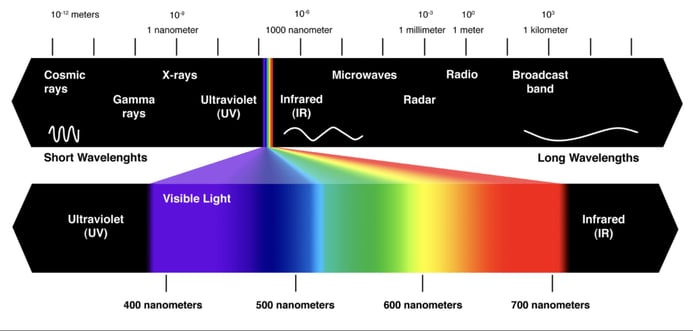
Posted on 02/03/2025 6:36:50 PM PST by Red Badger

There is something unique about the color purple: Our brain makes it up. So you might just call purple a pigment of our imagination.
It’s also a fascinating example of how the brain creates something beautiful when faced with a systems error.
To understand where purple comes from, we need to know how our eyes and brain work together to perceive color. And that all begins with light.
Light is another term for electromagnetic radiation. Most comes from the sun and travels to Earth in waves. There are many different types of light, which scientists group based on the lengths of those waves. (The wavelength is the distance between one wave peak and the next.) Together, all of those wavelengths make up the electromagnetic spectrum.
Our eyes can’t see most wavelengths, such as the microwaves used to cook food or the ultraviolet light that can burn our skin when we don’t wear sunscreen. We can directly see only a teeny, tiny sliver of the spectrum — just 0.0035 percent! This slice is known as the visible-light spectrum. It spans wavelengths between roughly 350 and 700 nanometers.
The acronym ROYGBIV (pronounced Roy-gee-biv) can be used to remember the order of colors in that visible spectrum: red, orange, yellow, green, blue, indigo and violet. You can see these colors in a rainbow stretching across the sky after a rainstorm or when light shines through a prism. In the visible spectrum, red light has the longest wavelength. Blue and violet are the shortest. Green and yellow sit toward the middle.
Although violet is in the visible spectrum, purple is not. Indeed, violet and purple are not the same color. They look similar, but the way our brain perceives them is very different.

How we see color
Color perception starts in our eyes. The backs of our eyes contain light-sensitive cells called cones. Most people have three types. They’re sometimes called red, green and blue cones because each is most sensitive to one of those colors.
But cones don’t “see” color, notes Zab Johnson. Instead, they detect certain wavelengths of light.
Johnson works at the University of Pennsylvania in Philadelphia. She and other scientists who study how we perceive color prefer to classify cones based on the range of wavelengths they detect: long, mid or short.
So-called red cones detect long wavelengths of light. Green cones respond most strongly to light in the middle of the visible spectrum. Blue cones best detect wavelengths toward the shorter end of the visible spectrum.
When light enters our eyes, the specific combination of cones it activates is like a code. Our brain deciphers that code and then translates it into a color.
Consider light that stimulates long- and mid-wavelength cones but few, if any, short-wavelength cones. Our brain interprets this as orange. When light triggers mostly short-wavelength cones, we see blue or violet. A combination of mid- and short-wavelength cones looks green. Any color within the visible rainbow can be created by a single wavelength of light stimulating a specific combination of cones.
:max_bytes(150000):strip_icc():format(webp)/the-visible-light-spectrum-2699036_FINAL2-c0b0ee6f82764efdb62a1af9b9525050.png)
Notice that the visible spectrum is a gradient. One color gradually shifts into the next. The activity of cones activated by the light also gradually shifts from one type to the next. At the red end of the spectrum, for instance, long-wavelength cones do most of the work. As you move from red to orange, the mid-wavelength cones help more and the long-wavelength cones do less.
In the middle of the rainbow — colors like green and yellow — the mid-wavelength cones are busiest, with help from both long- and short-wavelength cones. At the blue end of the spectrum, short-wavelength cones do most of the work.
But there is no color on the spectrum that’s created by combining long- and short-wavelength cones.
This makes purple a puzzle.
Purple is a mix of red (long) and blue (short) wavelengths. Seeing something that’s purple, such as eggplants or lilacs, stimulates both short- and long-wavelength cones. This confuses the brain. If long-wavelength cones are excited, the color should be red or near to that. If short-wavelength cones are excited, the color should be near to blue.
The problem: Those colors are on opposite ends of the spectrum. How can a color be close to both ends at once?
To cope, the brain improvises. It takes the visible spectrum — usually a straight line — and bends it into a circle. This puts blue and red next to each other.
“Blue and red should be on opposite ends of that linear scale,” Johnson explains. “Yet at some point, blue and red start to come together. And that coming-together point is called purple.”
Our brain now remodels the visible spectrum into a color wheel and pops in a palette of purples — which don’t exist — as a solution to why it’s receiving information from opposite ends of the visible spectrum.
Colors that are part of the visible spectrum are known as spectral colors. It only takes one wavelength of light for our brain to perceive shades of each color. Purple, however, is a nonspectral color. That means it’s made of two wavelengths of light (one long and one short).
This is the difference between violet and purple. Violet is a spectral color — part of the visible spectrum. Purple is a nonspectral color that the brain creates to make sense of confusing information.
Purple thus arises from a unique quirk of how we process light. And it’s a beautiful example of how our brains respond when faced with something out of the norm. But it’s not the only color that deserves our admiration, says Anya Hurlbert.
“All colors are made up by the brain. Full stop,” says this visual scientist at Newcastle University in England. They’re our brain’s way of interpreting signals from our eyes. And they add so much meaning to things we perceive, she says.
“The color of a bruise tells me how old it is. The color of a fruit tells me how ripe it is. The color of a piece of fabric tells me whether it’s been washed many times or it’s fresh off the factory line,” she says. “There’s almost nothing else that starts with something so simple [like a wavelength of light] and ends with something so deep and rich.”
“Tsk, tsk, tsk; fallacious argument.”
Not an argument. A statement of fact.
Not since 7th grade gym class!.....................
Your statement ended with a period, not a question mark.
Thank you. My thoughts exactly
Although violet is in the visible spectrum, purple is not …Oh boy. Most colors are not part of the light spectrum; there is no brown in the spectrum either.
Insert (long & loud burping) emoji > > > here.
Wiki: purple
In optics, violet is a spectral color; it refers to the color of any different single wavelength of light on the short wavelength end of the visible spectrum, between approximately 380 and 450 nanometers,[58] whereas purple is the color of various combinations of red, blue, and violet light,
Some colors seem to be formed by dithering as well.
Rates right up there with Silent Lucidity.
If purple exists only in my brain, what’s it doing on my mattress?
‘Scuse me while I kiss the sky!
Thanks for posting this. I work in color science and this article is for the most part correct, but the author makes a few confusing statements along the way. All perceived colors are made up by the brain, not just purple. Spectral colors (the colors of the rainbow) are the colors we see when the light falling on the cone cells is from a narrow band of wavelengths. Purple is not a spectral color because it cannot be perceived by stimulating the cone cells with a single narrowband light source, but requires at least two narrowband wavelengths at opposite ends of the spectrum, one that stimulates the short wavelength cone cells and the other that stimulates the long wavelength cone cells. Violet (as defined by color scientists) and which most people perceive as similar to purple in color is perceived when only the short wavelength cone cells are being stimulated.
Look...the article is up for grabs, some agree with it, some don't, but when all is said and done, what it really boils down to is WHO CARES?
The accompanying photos are CRAP! Not everything in the first photo, of fruits and veggies, include RED items that don't belong, since the article is about PURPLE.
The spectrum chart is also off since it omits shades.
If, as you state, in garbled, incorrect English: "Any pigments does not produce a single frequency. It emits a combination of frequencies", then each color, on it's own produces MANY frequencies.
Yet colors that are a combination of other colors, such as green, would produce even MORE frequencies?
Then WHY would different people see the same color differently, IF we are all seeing the same frequencies and does it even matter?
And IF people who are colorblind have brains that aren't broken/inferior/whatever, then WHY are they colorblind?
What about people who aren't colorblind but see a color or many colors differently?
Because I am color sensitive/shade sensitive ( meaning that I can easily tell the differences in tone and quality ), does that mean that my brain works better than most, or just differently? Or is it that this is because I have been painting most of my life?
If the midpoint theory is true the midpoint between red and green should orange/yellow. But the color we see when we mix red and green is yellow.
People who are color blind lack one or more of the three types of cone cells.
Best listened to through some hi-quality headphones. Happy to expand your horizons.
Namely, the profound difference between Transmitted and Reflected colors.
Transmitted color is when the primary source of the light hits the eyeball directly, without reflection off an object.Example:Reflected color is when we view an object that is being illuminated by a source, but we're not looking at the source's light directly.
When you combine all the colors of the spectrum together, if you do it with light sources, you get WHITE. But if you combine all the colors of the spectrum together using pigments (paint), you get BLACK.So before you two make us all any crazier, please address that in your discussion of how colors combine. It's an essential factor that appears to be missing in this thread.
And....a single pigment, though ONLY one color, gives off "many frequencies"? How so?
Does a color that contains many different pigments give of MORE frequencies, even when it is in the same color family?
Lets take red...there are many different shades of red, yet one and only ONE color red, can be purchased as a single pigment paint, whilst that SAME color, can also be purchased that has more than one pigment to make that SAME color.
Ergo, IF, as you claim, that color gives off many frequencies, BUT one contains ONLY one pigment and others contain at least 2, wouldn't the frequencies change? And IF that was to occur, then wouldn't we see a difference in color, but we DO NOT!
Just don’t show that to the trannies.
Disclaimer: Opinions posted on Free Republic are those of the individual posters and do not necessarily represent the opinion of Free Republic or its management. All materials posted herein are protected by copyright law and the exemption for fair use of copyrighted works.